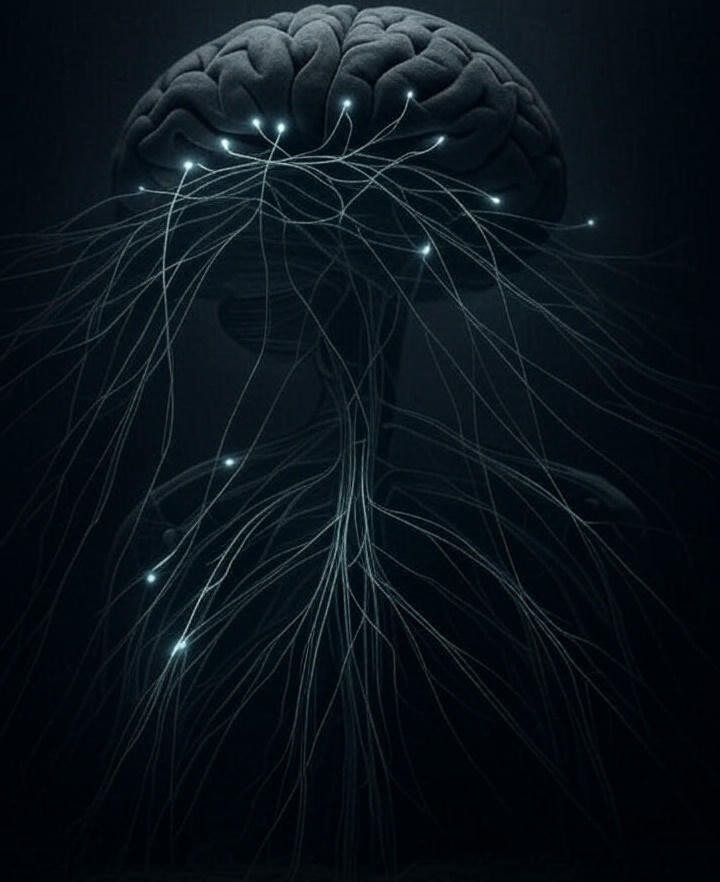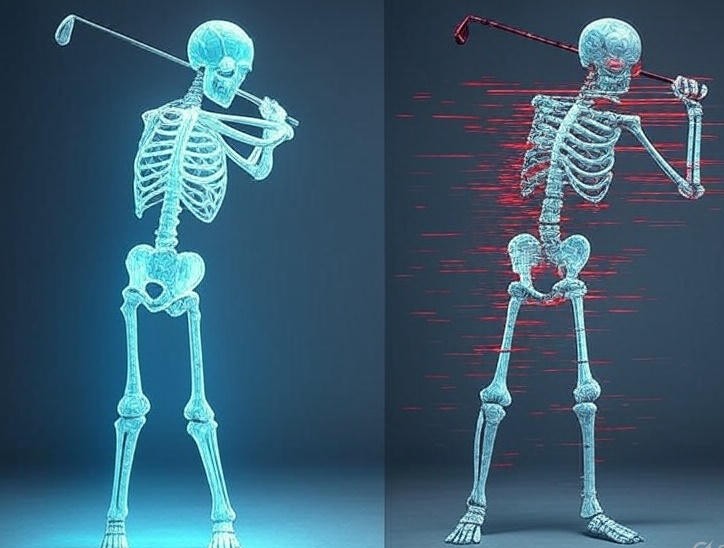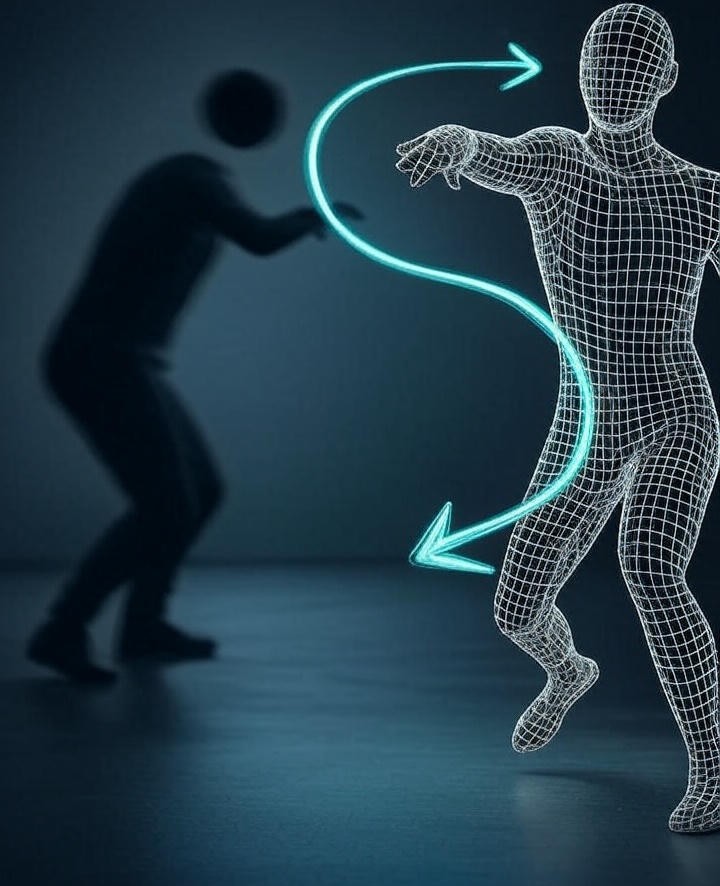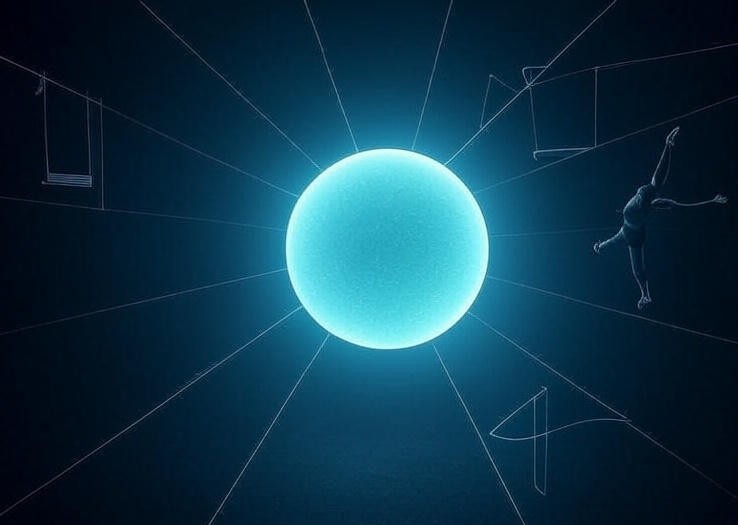It’s a moment every athlete dedicated to improvement has faced. You know you need to change your technique. Perhaps a coach identified a critical flaw, or you watched a video of an expert and had a breakthrough insight. You head to the range, the court, or the gym with a clear, singular mission: "This time, I will keep my elbow tucked in," or "I'm going to finish my follow-through high."
You concentrate with all your mental might. You perform the movement, and it feels different—maybe awkward, but you believe you are executing the new instruction. In your mind, you are consciously keeping that elbow in, you are holding that follow-through. You are giving your body the correct commands.
Then comes the moment of truth. You watch the video replay. The player on the screen is a stranger. The movement they performed is not only different from what your coach instructed, and completely different from what you wanted to do—it’s also profoundly different from what you thought you were doing. The elbow still flares out. The follow-through still drops.
This jarring disconnect, this chasm between your intention, your perception, and the objective reality, is the single most universal frustration in skill acquisition. It’s a ghost in the machine of your body, a phantom that misinterprets your commands and sabotages your best intentions. This isn't a lack of talent or effort. It is a fundamental, biological limitation in how the human brain communicates with the body during complex, high-speed movement.
For decades, we’ve tried to exorcise this ghost with mirrors and video cameras, tools that show us the "real" and force us to confront the lie of our "feel." But while these tools are brilliant at diagnosing the problem, they are incomplete solutions for fixing it. This article will explore the deep science behind this "feel vs. real" phenomenon. We will deconstruct why your body’s internal navigation system can be so unreliable and examine the inherent limitations of video-based feedback. Finally, we will illuminate a path forward—a way to provide your brain with an incorruptible, objective truth that finally bridges the gap, ending the guesswork and placing you on a direct path to tangible improvement.
Part 1: The Anatomy of 'Feel'—Your Body's Internal GPS
To understand why our 'feel' can be so deceptive, we must first appreciate the astonishing biological system that creates it. This system is called proprioception. Often referred to as our "sixth sense," proprioception is the brain's ability to know where the body is in space without relying on sight or sound. It’s the continuous, unconscious stream of data from millions of microscopic sensors embedded in your muscles, tendons, and joints.
These sensors work in harmony to create a living, three-dimensional map of your body in your brain:
- Muscle Spindles: These microscopic receptors, located within the belly of your muscles, detect changes in muscle length and the speed of that change. They are the sensors that tell your brain how far and how fast a limb is moving.
- Golgi Tendon Organs (GTOs): Situated where the muscle fibers connect to the tendon, GTOs sense changes in muscle tension or force. They are the body's internal force plates, constantly reporting how hard a muscle is working.
- Joint Receptors: Found in and around the joint capsules, these receptors provide information about joint angle, pressure, and inflammation, helping the brain understand the position of the skeleton.
Together, this network feeds a torrent of information to the central nervous system, allowing you to walk without looking at your feet, touch your nose with your eyes closed, and lift a glass of water with the perfect amount of force. For 99% of human activity, proprioception is a biological marvel of precision and efficiency.
So why does this magnificent system seem to fall apart when we try to execute a complex athletic skill? The answer lies in the unique demands of high-speed, multi-joint movements. When you perform an action like a golf swing, which involves a precise sequence of dozens of muscles firing in a fraction of a second, the sheer volume and velocity of proprioceptive data can overwhelm the brain’s processing capacity. The signal becomes noisy, and the brain, in an effort to make sense of the chaos, can make crucial errors in its interpretation. It is at the precise moment that we need our internal GPS the most that it becomes the least reliable.

Part 2: The Grand Deception—When and Why Your Brain Lies
The breakdown of our 'feel' is not random; it’s a predictable outcome of how the brain learns and operates under pressure. The inaccuracy stems from a combination of flawed internal blueprints and the brain's survival-oriented habit of taking mental shortcuts.
Flawed Blueprints: The Problem of the "Incorrect" Feeling
The brain stores movement patterns as motor schemas, or internal models of a skill. When you learn a new skill, you slowly build this schema through repetition. The problem is, if you learn the movement incorrectly—with a slight flaw in your technique—your brain doesn't know it's a flaw. It simply records the pattern.
Through thousands of repetitions, this flawed pattern becomes your brain's definition of "correct." The specific constellation of muscle tension, joint angles, and timing associated with that incorrect movement becomes your 'feel' for the skill. When a coach later tells you to change your movement, they are asking you to do something that, to your brain, feels fundamentally wrong. Your internal sense of correctness is anchored to the flawed schema. This is why it is so difficult to break bad habits; you are not just fighting a physical tendency, you are fighting your own brain's definition of what the movement is supposed to feel like.
To truly fix a flaw, you must do more than just see it on video; you must physically overwrite the old, incorrect motor schema with a new, correct one. This requires a process of deep, focused practice aimed at physically changing your brain's structure. It’s about leveraging the principles of neuroplasticity to blaze a new trail, one that feels alien at first but eventually becomes the new standard of 'correct'. This is the hard work of rewiring your brain for faster skill acquisition.

Sensory Weighting: How the Brain Filters Reality
A second critical factor is a phenomenon known as sensory reweighting. Your brain is constantly being bombarded with information from all your senses. To prevent being overwhelmed, it dynamically "weighs" or prioritizes certain inputs over others based on the context of the task.
Research in motor control, particularly the work of pioneering scientists in the field of motor learning, has shown that when performing a complex skill, the brain often gives more weight to exteroceptive feedback (information about the external environment, like the location of the target) than it does to proprioceptive feedback (information about the body's own movements).
Think about a basketball player shooting a free throw. Their primary goal is to get the ball in the hoop. Their brain instinctively prioritizes visual information about the target. In doing so, it may down-weight the proprioceptive signals from their shooting elbow. The player might think their elbow is tucked in because their attention is so heavily focused on the rim. The brain is making a trade-off: it sacrifices a degree of bodily awareness to maximize focus on the goal. This explains why an athlete’s form can break down under pressure; their brain is actively de-prioritizing the 'feel' of their own body in favor of focusing on the outcome.
Part 3: The Flawed Mirror—Why Video Alone Is Not the Answer
For the past three decades, video analysis has been the gold standard for confronting the feel vs. real problem. It provides undeniable, visual proof of our mechanical flaws and is an indispensable tool for every serious coach and athlete. It is the perfect mirror for diagnosing the what.
However, as a tool for fixing the what, video has profound limitations. Relying solely on video for feedback creates an inefficient and often frustrating learning loop.
- It’s a Lagging Indicator: Video provides feedback after the fact. You perform the repetition, walk over to a screen, watch the replay, and then try to apply that learning to the next rep. In the time it takes to complete this cycle, you have already allowed an incorrect motor pattern to be performed and even subtly reinforced. Effective learning requires feedback that is as close to instantaneous as possible.
- It Only Shows Outcomes, Not Causes: A camera can show you that your club was off-plane or that your arm was in the wrong position. It cannot tell you why. It cannot measure the underlying biomechanical data—the rotational velocities, the sequence of force application, the subtle timing errors—that caused the visible flaw. It shows you the symptom, but it cannot definitively diagnose the root disease.
- It Creates a Difficult Translation Problem: Watching a 2D video and attempting to translate that visual information into a 3D physical feeling is an intensely difficult cognitive task. You see your mistake on screen, but you still don’t know what the correct movement is supposed to feel like. You are left to guess, making micro-adjustments and hoping one of them is right. This process is slow, inefficient, and often leads to over-correction and further confusion.
Video is an essential first step. It proves the ghost in the machine exists. But to truly fix the flaw it reveals, we need a tool that can see beyond the visible, measure the invisible, and provide feedback with a precision and immediacy the human eye and a camera simply cannot match.

Part 4: The Unbiased Observer—Bridging the Gap with Objective Data
The ultimate solution to the feel vs. real dilemma is to introduce a new source of truth into your practice—an unbiased observer that doesn't guess or interpret, but simply measures. This is the role of modern sensor technology. By utilizing high-precision inertial measurement units (IMUs), we can move beyond simple video and conduct a true biomechanical analysis of your movement in real-time.

These sensors act as a direct bridge between your subjective 'feel' and objective reality. They don’t just show you what your movement looked like; they tell you precisely what it was. This approach transforms the learning process in three critical ways.
1. It Provides Quantitative, Not Just Qualitative, Feedback
Where video gives you qualitative feedback ("Your hips turned too slowly"), a sensor-based system provides quantitative data ("Your peak hip rotation velocity was 450 degrees/second, 20% slower than your target"). This numerical precision is a superpower for learning. It eliminates ambiguity and tells you the exact magnitude and direction of your error. This allows for hyper-specific corrections, turning a guessing game into a targeted, engineering-like process of improvement.
2. It Enables Real-Time Feedback Loops
Perhaps most critically, sensor systems can provide feedback with near-zero delay. By setting a target for a specific movement variable, the system can provide a simple, immediate signal—a sound or a vibration—the instant a repetition is completed. This immediate knowledge of results is a core principle of accelerated motor learning. It allows the brain to connect the feeling of the previous repetition directly with its objective outcome, rapidly calibrating 'feel' to 'real' in a tight, efficient loop. This eliminates the wasted time and mental energy of walking to a monitor and watching a replay. Every repetition becomes a focused, data-driven learning event.
3. It Measures the Invisible
The most profound advantage of a sensor-based system is its ability to measure the invisible forces that define elite performance. It can see the kinetic sequence—the precise order in which you generate speed and transfer energy through your body. It can measure acceleration and deceleration patterns that are imperceptible on video. This is the underlying "why" behind the visible "what." By making these invisible dynamics visible through data, an intelligent analytics engine can pinpoint the root cause of a flaw, not just its symptom, providing a clearer and more direct path to a permanent solution.
Conclusion: The End of Guesswork
The ghost in the machine—the frustrating gap between what we feel and what is real—is not a personal failing. It is a biological feature of the human nervous system. For too long, we have tried to fight this ghost with imperfect tools, relying on a cycle of subjective feeling and delayed visual feedback. This path is paved with frustration and wasted effort.
The science of motor learning now illuminates a better way. The journey to mastery is not about learning to trust your 'feel'. It is about making your 'feel' trustworthy.
This requires a new partnership between your body and an objective, unbiased observer. By embracing technology that provides precise, quantitative, and immediate feedback, you give your brain the ground truth it needs to build accurate internal models. You replace the noise of subjective guesswork with the clarity of objective data. You stop battling the ghost and instead provide it with a clear, incorruptible guide.
This is the end of practicing in the dark. This is the end of the maddening cycle of trying to "feel" your way to a solution that you can't define. This is the beginning of a new kind of practice—one that is focused, efficient, and relentlessly effective.
The path is now clear.
